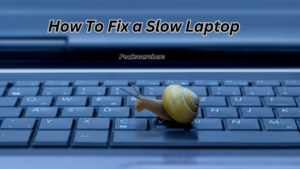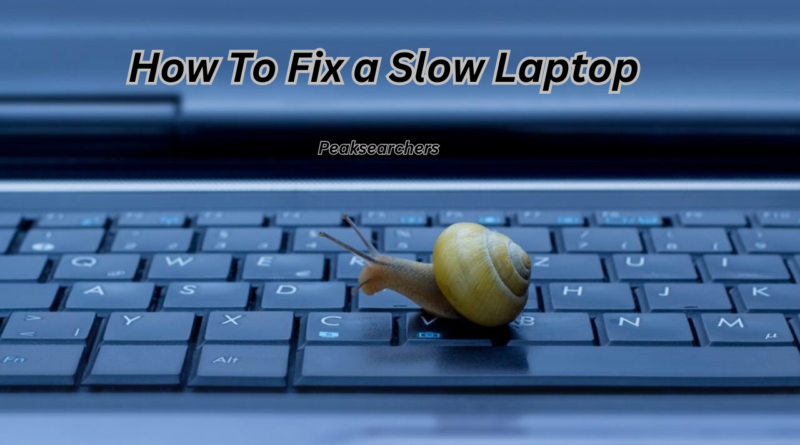How to Fix a Slow Laptop? A Comprehensive Guide
Welcome to our comprehensive guide on how to fix a slow laptop. If you’re frustrated with your laptop’s sluggish performance, you’ve come to the right place. In this article, we will provide you with step-by-step instructions and valuable insights to help you optimize your laptop’s speed and efficiency. We understand the importance of a fast and responsive laptop, and we are committed to helping you achieve that.

Understanding the Causes of a Slow Laptop
Before we delve into the solutions, it’s crucial to understand the potential causes of a slow laptop. By identifying the underlying factors, we can address them effectively and restore your laptop’s performance. Here are some common culprits:
- Insufficient RAM: Inadequate random-access memory (RAM) can significantly impact your laptop’s speed. We’ll explain how to determine if your laptop needs more RAM and guide you through the process of upgrading it.
- Fragmented Hard Drive: Over time, files on your hard drive can become fragmented, leading to slower read and write speeds. We’ll show you how to defragment your hard drive and optimize its performance.
- Startup Programs: Too many unnecessary programs launching at a startup can consume valuable system resources. We’ll walk you through the steps to manage your startup programs effectively.
- Malware and Viruses: Laptop performance can be compromised by malware and viruses. We’ll help you understand the importance of robust antivirus software and guide you in selecting and using the right tools to protect your laptop.
Step-by-Step Guide to Speeding up Your Laptop
1. Assessing Your Laptop’s Hardware
To begin the optimization process, we need to assess your laptop’s hardware capabilities. This step will help us identify any potential limitations and determine the most suitable solutions.
2. Increasing RAM Capacity
If your laptop lacks sufficient RAM, upgrading it can significantly enhance its performance. We’ll guide you through the process of identifying the RAM type, selecting compatible modules, and installing them correctly.
3. Optimizing Your Hard Drive
A fragmented hard drive can hinder your laptop’s speed. We’ll demonstrate how to defragment your hard drive using built-in tools or third-party software, ensuring smooth data access and improved performance.
4. Managing Startup Programs
Unnecessary programs launching at startup can slow down your laptop’s boot time. We’ll show you how to identify and disable unwanted startup programs, allowing your laptop to start up quickly and efficiently.
5. Cleaning Up Your Laptop
Over time, temporary files, cache, and other junk accumulate on your laptop, affecting its performance. We’ll provide step-by-step instructions on removing unnecessary files using built-in cleanup tools or trusted third-party applications.
6. Updating Drivers and Software
Outdated drivers and software can hinder your laptop’s performance and security. We’ll explain the importance of keeping them up to date and guide you through the process of identifying and updating outdated drivers and software.
7. Scanning for Malware and Viruses
Malware and viruses can significantly impact your laptop’s performance and compromise your data. We’ll recommend powerful antivirus software, explain how to perform thorough scans and provide guidance on removing any detected threats.
8. Optimizing Power Settings
Adjusting power settings can conserve energy and improve laptop performance. We’ll discuss different power plans, demonstrate how to customize them to suit your needs and provide recommendations for achieving the right balance between performance and battery life.
9. Utilizing Resource Monitoring Tools
Monitoring your laptop’s resource usage can help identify any bottlenecks or performance issues. We’ll introduce you to helpful resource monitoring tools and explain how to interpret the data they provide.
10. Seeking Professional Assistance
If you’ve followed all the steps diligently and your laptop still experiences performance issues, it may be time to consult a professional. We’ll provide guidance on finding reliable service centers or technicians who can diagnose and resolve complex hardware or software problems.
Also Read: How To Connect Nintendo Switch To Laptop? A Comprehensive Guide
FAQ’s
Why is my laptop running so slow?
There are several reasons why your laptop might be running slow:
- Insufficient RAM (memory)
- Low storage space
- Malware or viruses
- Outdated software or operating system
- Background processes using resources
- Overheating
- Hardware limitations
To improve performance, try these steps:
- Restart your laptop.
- Clear unnecessary files.
- Update software and drivers.
- Run a malware scan.
- Manage startup programs.
- Clean the cooling system.
If the problem persists, consult a technician.
How can I make the laptop run faster?
To make your laptop run faster, you can try the following steps:
- Close unnecessary programs: Close any unused applications running in the background to free up system resources.
- Remove startup programs: Disable unnecessary programs from launching at startup to reduce the burden on your laptop’s performance.
- Free up disk space: Delete unnecessary files, such as temporary files, old downloads, and unused applications, to create more storage space on your hard drive.
- Run a disk cleanup: Use the built-in disk cleanup tool on your operating system to remove temporary files and system clutter that can slow down your laptop.
- Upgrade your RAM: If your laptop has limited memory, upgrading the RAM can provide a significant performance boost, especially when running memory-intensive tasks.
- Upgrade your storage drive: Consider replacing your traditional hard drive with a solid-state drive (SSD) for faster data access and improved overall performance.
- Update software and drivers: Keep your operating system, drivers, and applications up to date to benefit from bug fixes, performance enhancements, and compatibility improvements.
- Scan for malware and viruses: Run a reliable antivirus or anti-malware program to scan your laptop and remove any malicious software that may be impacting its performance.
- Adjust power settings: Optimize your laptop’s power settings to prioritize performance over energy-saving features. Select the “High Performance” power plan if available.
- Restart your laptop regularly: Restarting your laptop can help clear temporary files and refresh system resources, improving performance.
Remember, if your laptop is older or has hardware limitations, there may be limits to how much you can improve its performance. In such cases, upgrading specific hardware components or considering a new laptop might be necessary for a significant boost in speed.
Why is my laptop lagging and freezing?
Your laptop may be lagging and freezing due to various reasons:
- Insufficient RAM.
- High CPU usage.
- Overheating.
- Limited storage space.
- Outdated or incompatible drivers.
- Malware or viruses.
- Resource-consuming background processes.
To resolve the issue:
- Close unnecessary applications and processes.
- Upgrade your RAM.
- Monitor CPU usage and close resource-intensive tasks.
- Check for overheating and clean your laptop’s vents.
- Free up storage space.
- Update drivers.
- Run antivirus scans.
If the problem persists, seek professional assistance.
How do I clear the RAM on my laptop?
To clear the RAM on your laptop, you can follow these steps:
- Close unnecessary programs: Close any unused applications running in the background to free up memory.
- Restart your laptop: A simple restart can help clear out temporary data stored in the RAM.
- Use the Task Manager (Windows) or Activity Monitor (Mac): Press Ctrl+Shift+Esc (Windows) or Command+Spacebar, type “Activity Monitor,” and press Enter (Mac) to open the respective utility. In the “Processes” or “Memory” tab, you can identify and close memory-intensive processes or applications.
- Disable startup programs: Prevent unnecessary programs from launching at startup, as they consume memory from the beginning. You can manage startup programs through the Task Manager (Windows) or System Preferences > Users & Groups > Login Items (Mac).
- Adjust visual effects: Reduce the visual effects on your operating system to allocate more RAM for other tasks. On Windows, right-click on “This PC” or “My Computer,” select “Properties,” go to “Advanced System Settings,” click “Settings” under the “Performance” section, and choose “Adjust for best performance” or customize individual settings. On Mac, go to System Preferences > Dock & Menu Bar > uncheck unnecessary visual effects.
- Clear browser cache: If your web browser is consuming a significant amount of memory, clearing the cache can help. The steps vary depending on the browser you’re using, but generally, you can access the browser’s settings or preferences and find the option to clear the cache.
- Upgrade your RAM: If you consistently find your laptop’s RAM insufficient, upgrading to a higher capacity can provide more memory for smoother multitasking.
It’s important to note that manually clearing the RAM may provide temporary relief, but the operating system typically manages memory automatically. It’s designed to allocate and deallocate memory as needed.
Also Read: Why Won’t My Dell Laptop Turn On? A Complete Solution
Conclusion
Congratulations on completing our comprehensive guide on how to fix a slow laptop. By following the steps outlined above, you should see a noticeable improvement in your laptop’s speed and overall performance.
Remember, a well-optimized laptop can significantly enhance your productivity and user experience. We hope this guide has empowered you to take control of your laptop’s performance and enjoy a fast and efficient computing experience.


